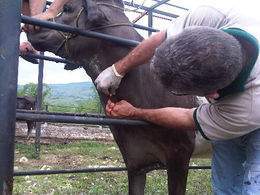Equine brucellosis. Infectious contagious disease of equines caused by the bacteria Brucella abortus or B. suis. In horses, the bacteria produce the diseases known as fistulous cross and nape ulcer, characterized by inflammation of the supraspinatus and supra Atlanta joint bags respectively.

Definition
Percutaneous oro-nasal transmission infectious disease. It affects the cervical ligament, tendon sheaths, synovial bags, and joints. Equine, ruminant, canine and human are susceptible. It is not seasonal and has an incubation period of 2-4 weeks. It is a notifiable zoonosis.
Transmission and propagation
As a general rule, brucellosis is transmitted when a sick animal aborts and calves. In the fluids from the delivery of this animal there will be a large number of bacteria , which can survive for several months in the external environment, especially in cold and humid conditions, and remain infectious for other animals, which will be infected by ingesting them. Bacteria also colonize the udders and contaminate the milk.
Brucellosis can also be transmitted to animals and people through wounds on the skin or mucous membranes.
Brucellosis is an important disease in wildlife, affecting wild pig , bison , elk, and European hare . The presence of a reservoir in wildlife complicates the fight to eradicate the disease . Brucellae have also been detected in marine mammals .
Risks
Brucellosis is an extremely infectious zoonosis for humans, causing a condition often called undulating fever or Maltese fever , as it was first described in Malta in the 1850s .
The human being presents symptoms such as intermittent or irregular fever, headache, weakness, profuse sweating, chills, weight loss and general pain. Infection of organs such as the liver or spleen can also occur .
Veterinarians, farmers and slaughterhouse employees are exposed to infection when they handle infected animals or fetuses or placentas after an abortion .
Brucellosis is one of the infections that is most easily transmitted in the laboratory, so when handling cultures or samples with a large number of bacteria , such as the material resulting from an abortion, strict safety measures should be observed. People can also be infected by consuming unpasteurized milk from infected animals .
Clinical signs
It is usually a mild disease , and the infected female shows few clinical signs until abortion. Testicular inflammation is sometimes seen in males, and occasionally the bacteria settle in the joints, where they cause arthritis .
In horses it causes a condition called fistulous cross, which causes inflammation of the neck or back. Pregnant mares can abort, or give birth to a weak and vulnerable foal.
The importance of brucellosis is that it greatly reduces reproductive performance, due to cases of abortion , infertility, placental retention, neonatal mortality or weakness of the progeny. All this translates into considerable economic losses for producers of dairy cattle, sheep , goats or pigs .
Diagnosis
Although the presence of brucellosis can be suspected in the case of clinical signs such as abortions , confirmation requires serological tests, followed by prescribed laboratory tests to isolate and identify the bacteria , in accordance with the guidelines on methods and threshold values for diagnosis contained in OIE Manual of Standards for Diagnostic Tests and Vaccines for Terrestrial Animals .
Prevention
Surveillance for screening purposes can involve routine serological testing and analysis of milk , using techniques such as the milk ring test. These surveillance measures can be of great help in campaigns to eliminate the disease . Analysis of individual animals is also carried out for trade or disease control purposes.
In areas where brucellosis is endemic, vaccination is often used to reduce the incidence of infection . There are several vaccines with modified live viruses , and when elimination of the disease is close, a program of diagnostic tests and health sacrifices must be applied to eradicate it completely.
The best way to prevent human brucellosis is to fight the infection in animals . The pasteurization of the milk of infected animals was once very important to reduce the levels of infection in people.
